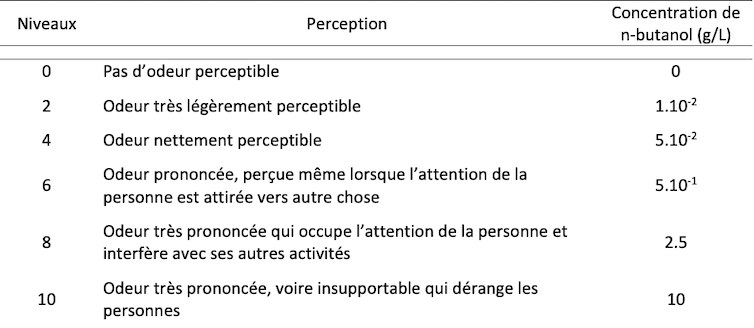In the race for natural cosmetic products, the search for the slightest smell is often a criterion. What about these ingredients? Is natural necessarily risk-free?
This article was not written by the editorial staff of La Dépêche du Midi, but taken from the partner site The Conversation.
Everyone uses cosmetic products on a daily basis. Creams, gels, shampoos, sunscreen and hair products… they are indeed essential to clean, protect and maintain our skin, our teeth or our hair. Beyond this aesthetic use, they also contribute to our health, by limiting the premature aging of tissues or by protecting us against UV A and UV B from the Sun, which is so dangerous for our skin in terms of sunscreens.
Nevertheless, a real awareness has been made in recent years about these ubiquitous products.
Studies have, for example, made it possible to suspect some of containing endocrine disruptors. These concerns are pushing more and more consumers to favor those who put forward reassuring arguments: absence of allergens, fragrance, 100% natural, etc.
In fact, cosmetics often contain many ingredients – which can be questionable. Thus, a simple moisturizer can contain several dozen: moisturizing agents, fatty substances, surfactants, preservatives, active ingredients… and perfumes.
What impact for perfumes?
Perfumes are generally made from various compounds: natural or synthetic molecules associated with plant extracts, such as essential oils, assembled to create a pleasant scent.
Favoring natural ingredients is a strong current trend in this area. Among the most used, there are essential oils of lavender or sweet orange which are composed of molecules such as linalool or limonene.
Why this precision? Because these two natural molecules are not, contrary to popular belief, without danger. Their use is also regulated in cosmetic products because they are allergenic – linalool can cause eczematous-type reactions. Their presence must be indicated on the labels of cosmetic products.
It is not because a molecule is of natural origin that it is harmless! If it is used, it has an effect… It’s all about quantity.
Wouldn’t the easiest way be to favor an unscented cosmetic product – and without allergens?
Fragrance-free cosmetics?
We must return briefly to the roles of fragrances added to our skincare products. There are three main ones:
-
Create a pleasant smell and feel. When we apply a cream to our face, and therefore near our nose, it is more pleasant to associate a pleasant smell with it… There are also smells which are attached to a specific brand and which convey a positive valence. This is the case of the emblematic perfume of the famous crèmes au pot bleu;
-
Amplify the effectiveness of the product. Some perfumes can have a soothing or vitalizing character which can intensify its action. It can be cognitive or physiological – for example with a calming effect on heart rate;
-
Mask the smell of other ingredients. Some plant extracts used as anti-aging actives have unpleasant odors and can hardly be used alone.
When you develop a fragrance-free product, you lose these three effects.
But is a product without added fragrance necessarily odorless? Does it contain fewer chemical compounds? Things are not that simple…
In reality, a product from which its perfume has been removed will retain an odor. Less intense, it is not totally absent for all that.
Fragrance-free… but not odourless!
Odors are due to volatile compounds capable of reaching the olfactory receptors located in our nose. We have a very high sensitivity to odors and only a few molecules can be detected… An odorous compound in trace amounts will therefore be perceived.
The ingredients used can thus have their own smell. We are not talking here about the added perfumes, but about the constituent ingredients of the cosmetic product used: moisturizing agents, fatty substances, surfactants, preservatives, active ingredients… And if the ingredients have an odor, then the cosmetic will also be fragrant. Possibly more troublesome, there may be interactions between compounds, generating new scents.
Assessing the intensity of an odor is not easy, and there is no universal measuring instrument. For this reason, the evaluation is usually carried out by… human noses! This type of olfactory analysis can turn out to be very subjective, hence the importance of the precautions to be considered around the number of evaluators and the rating scale used.
To compensate for differences in sensitivity between individuals, the panel is made up of at least ten volunteers. And to ensure the consistency of their evaluations (a given intensity must be equivalent for all), a series of reference solutions is transmitted to them – in general the molecule of n-butanol, naturally present in many foods and smelling rather unpleasant, diluted in water in several concentrations. The results make it possible to “calibrate”, “calibrate” the panel.

We can thus evaluate the intensity of the smell of a perfumed moisturizer, which is on average 8/10. The same cream without added perfume will have a weaker smell, rated at 2.5/10, which is not much… but not zero.
What are the most fragrant compounds?
Among the potentially odorous ingredients, we can mention oils and fats which have a slight vegetal or nutty odor. Called emollients in cosmetics, they are essential and are found in skin or hair care products because they protect, soften and nourish our tissues.
Their residual odor is due to the presence of compounds commonly found in nature such as greasy-smelling aldehydes, fruity esters or alcohols.
To create an odorless cosmetic product, it would therefore be necessary to use odorless ingredients… which must be created. We are therefore moving away from the natural. This is the subject of work in our research laboratory.
Identifying volatile compounds and providing “targeted remediation” can reduce the smell of emollients: we will seek to eliminate or reduce the presence of specific molecules… But which ones to target? The most abundant?
Here again, it’s not that simple… Sometimes low-abundant compounds can have an odorous power: they are therefore the ones to target. It is then necessary to isolate, identify and quantify these chemical elements. Chemical analyzes are combined with sensory analysis because it is literally all about the nose. Thanks to these works, the residual odor can go from an intensity of 4/10 to 2/10, which is practically undetectable.

Another very common type of ingredient that can have an odor is conservatives, for example phenoxyethanol or parabens. These two synthetic preservatives have pejorative connotations because they are suspected of being a skin allergen for one and an endocrine and reproductive disruptor for the other.
They are authorized in cosmetic products, but their use is restricted and regulated at the level of the maximum doses of use. Alongside these highly monitored potential health effects, however, there are essential ingredients hidden: in particular, they prevent the development of micro-organisms in the presence of water, thus guaranteeing adequate preservation over time, even at low doses.
Like oils and fatty substances, they also have a characteristic smell, in this case a rather pleasant flowery scent! A pleasant scent is of course not the criterion for selecting a compound. One might argue that it is better to choose natural replacements… except that they are often more fragrant than their synthetic counterpart.
We can cite natural vegetable oils (4/10) which have a higher olfactory intensity than synthetic silicones (1/10). These odorless silicones are, however, subject to controversy regarding their environmental and health impacts.
In the end, odorless cosmetics (ingredient and product), is that possible? Yes, and this is even the case for the most used ingredient in our moisturizers: pure water!
Natural, odorless, fragrance-free: keeping things in mind
“Natural”, “fragrance-free”, “allergen-free”… As we can see, there are many shortcuts, as are the contradictions that emerge when we try to minimize the impact of our daily products on health.
Thus, there is today a desire to move towards ever more odorless cosmetics, which have become a guarantee of quality for the general public – and, therefore, a competitive advantage for ingredient suppliers.
But if we can now reduce the presence of perfume, and therefore of allergens, and design neutral cream bases, this requires the implementation of new purification stages that are sometimes energy-intensive during industrial production!
While the initial residual odor is innocuous, risk-free…
Scented products remain for the time being the majority in our cupboards and many remain attached to the smell of their shower gel or their body milk. However, there is a desire to move towards ever more natural fragrances.
If the “most natural” has imposed itself as a sales criterion, it should not be concluded that synthetic ingredients are necessarily “worse” than their natural counterparts. To really judge the harmfulness of a product, it is at the molecular level that we must look – this is the work of research: identifying the molecules at risk, at what concentration, in what environment… And it is a work still in progress!
Géraldine Savary, Teacher-researcher in sensory analysis in the field of aromas, perfumes and cosmetics, Le Havre Normandy University and Catherine Malhiac, Teacher-researcher at the Organic and Macromolecular Chemistry Research Unit, Le Havre Normandy University
This article is republished from The Conversation under a Creative Commons license. Read the original article.

